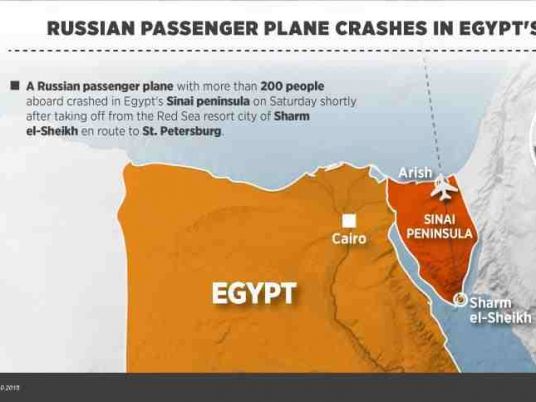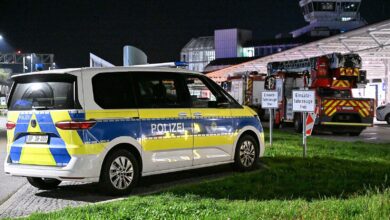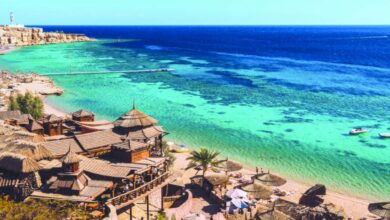
A Russian airliner carrying 224 passengers and crew crashed in Egypt's Sinai peninsula on Saturday after losing radar contact and plummeting from its cruising altitude, killing all aboard.
The Airbus A321, operated by Russian airline Kogalymavia under the brand name Metrojet, was flying from the Sinai Red Sea resort of Sharm el-Sheikh to St Petersburg in Russia when it went down in a desolate mountainous area of central Sinai soon after daybreak, the aviation ministry said.
A north Sinai security source said initial examination showed the crash was due to a technical fault, but gave no detail. The plane, he said, had landed in a "vertical fashion", explaining the scale of devastation and burning.
The Russian Embassy in Cairo said it had been told by Egyptian officials the pilot had been trying to make an emergency landing at El-Arish.
"I now see a tragic scene," an Egyptian security officer at the site told Reuters by telephone. "A lot of dead on the ground and many who died whilst strapped to their seats.
"The plane split into two, a small part on the tail end that burned and a larger part that crashed into a rock. We have extracted at least 100 bodies and the rest are still inside," the officer, who requested anonymity, said.
Sinai is the scene of an insurgency by militants close to Islamic State, who have killed hundreds of Egyptian soldiers and police and have also attacked Western targets in recent months.
Russia, an ally of Syrian President Bashar al-Assad, launched air raids against opposition groups in Syria including Islamic State on Sept. 30. Security sources said there was no indication the Airbus had been shot down or blown up.
TELEPHONES RINGING
Egyptian Prime Minister Sherif Ismail was heading to the crash site in the Hassana area 35 km (22 miles) south of the Sinai Mediterranean coastal city of Al Arish with several cabinet ministers on a private jet, the tourism ministry said.
Russian television showed film of anxious relatives and friends waiting for information at St. Petersburg's Pulkovo airport. A middle-aged woman was shown weeping and crying out.
Russian President Vladimir Putin declared a day of national mourning for Sunday. The passengers included 214 Russians and three Ukrainians.
Speaking at a news briefing in the central Asia republic of Kyrgyzstan, U.S. Secretary of State John Kerry described the crash as a tremendous tragedy and loss.
The A321 is a medium-haul jet in service since 1994, with over 1,100 in operation worldwide and a good safety record. It is a highly automated aircraft relying on computers to help pilots stay within safe flying limits.
Airbus said the A321 was built in 1997 and had been operated by Metrojet since 2012. It had flown 56,000 hours in nearly 21,000 flights and was powered by engines from International Aero Engines consortium, which includes United Technologies unit Pratt & Whitney and Germany's MTU Aero Engines .
Emergency services and aviation specialists searched the wreckage for any clues to the crash. One of two flight recorders was quickly found, but wreckage was scattered over a wide area.
The security officer said 120 bodies had been found intact.
"We are hearing a lot of telephones ringing, most likely belonging to the victims, and security forces are collecting them and putting them into a bag," he said.
Russian state-run television station Rossiya 24 reported that officials were searching the Kogalymavia airline's offices in Moscow and had seized some documents.
Interfax news agency said Russian state transport regulator Rostransnadzor had found violations when it last conducted a routine flight safety inspection of Kogalymavia. But after the inspection, in March 2014, the airline remedied the breaches.
Kogalymavia was founded in 1993, and was earlier called Kolavia. Its fleet consists of two A320s and seven A321s.
Russia and other former Soviet republics have relatively poor safety records, notably on domestic flights.
Some Russian air crashes have been blamed on the use of ageing aircraft, but industry experts point to other problems, including poor crew training, crumbling airports, lax government controls and neglect of safety in the pursuit of profits.
The aircraft took off at 5:51 a.m. Cairo time (0351 GMT) and disappeared from radar screens 23 minutes later, Egypt's Civil Aviation Ministry said in a statement. It was at an altitude of 31,000 feet (9,400 metres) when it vanished from radar screens.
Accidents at cruising altitude are one of the rarest categories of accidents but also among the most deadly, accounting for 13 percent of fatal incidents but 27 percent of fatalities since 2005, according to Boeing.
Investigators would be looking into, among other things, the weather at the time, the pilots' experience, maintenance records, signs of a stall and any evidence of an explosion. Experts consistently warn air accidents are usually caused by a cocktail of factors, both human and technical.
According to FlightRadar24, an authoritative Sweden-based flight tracking service, the aircraft was descending rapidly at about 6,000 feet (1,800 metres) per minute before the signal was lost to air traffic control.




